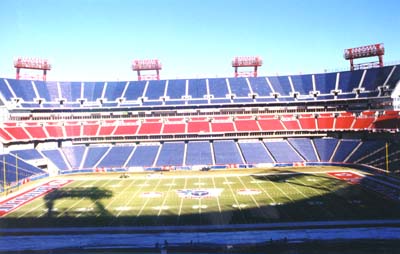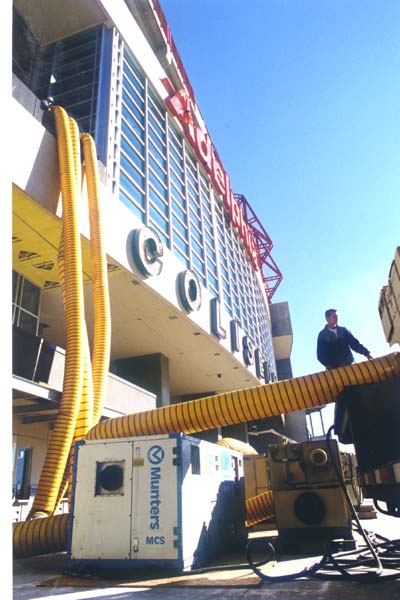
The high-pressure water main pumped an estimated 50,000 gallons onto the 150,000 sq ft fourth level club area, which then rained down onto other facilities including radio network offices, administrative offices, and a post-game interview room.
A disaster by any standard, Titans management needed a "Hail Mary" recovery just three days before the N.F.L. American Football Conference playoff game against the Baltimore Ravens.
"When I arrived on the scene, our people were sloshing around in two inches of water," said Bill Dickerson, Tennessee Titans general manager for facility operations. "With thousands of fans, CBS TV, and the national sports press corps converging on the stadium on Sunday, we were under great pressure to have our facility ready for the game."

Pruett had no idea what he might find at the stadium. But even as he rushed to meet with the Titans management, he had Munters' operations people loading equipment onto trucks and getting ready to come into the game.
Munters, a worldwide water damage recovery company, uses large industrial dehumidifiers to dry flooded areas. The dehumidifiers pump large volumes of dry air into wet environments. The dehumidified air rapidly dries carpet, ceiling tile, sheetrock walls, wood floors and building contents back to their pre-disaster condition.
"Our game plan," said Pruett, "was to have a significant amount of equipment at the stadium and running that day. This would start the drying. Then, a second team would arrive the next morning, increasing the drying power to the level needed to finish in the two days left before kickoff."
"One of our highest priorities was putting the high-end concession area back into operation before the game," said Dickerson. "We expected more than 6,000 fans to use this area, spending over $100,000 on food purchases during the game. Our fans expected to find these food services in place when they came to the playoffs.
"But our image was at stake, too," recalls Dickerson. "We had national television exposure with the playoffs, and after the game the press would want to use the interview room for post-game discussions. We needed to be dry at game time, no excuses." The Munters squad placed six M-20 dehumidifiers outside the stadium. This centralized system pumped more than 30,000 cubic feet of dry air into the water damaged areas every minute. Beyond this another M-20 supplemented by 80 smaller dehumidifiers and a half-mile of ductwork addressed other areas in the stadium.
The M-20 is a large industrial dehumidifier that Munters has created for fast action at water disasters. It is easily transported to the site, can be stacked to conserve space when in operation, runs on multiple utilities and is quickly set up.
While the drying continued around the clock, so did the other recovery efforts. "There was no time for Munters to finish before we had to start our own work," said Dickerson. "Munters knew how to handle that. They built their drying system so we could work alongside them to repair and clean the damaged areas."
By Saturday, it was clear that the stadium would be ready for the game, but Dickerson had other concerns.
"Munters had reversed the damage by game time. No one could tell that we had been under water on Wednesday," said Dickerson. "However, while the fans would never know we had a problem, there was still moisture in hidden places."
Pruett explains: "There's a period of time during water damage recovery when a building seems dry, but a dangerous amount of water still resides inside sheetrock walls, masonry or in ceiling cavities. We call this situation dry-to-the-touch. The job may seem finished, but a long-term risk still jeopardizes the building.
"If all of the moisture is not removed," Pruett continued, "after a period of time wall coverings begin to loosen, paint blisters, and mold and mildew begin to form. Many times, when drying is not thorough, major reconstruction must be done to reverse new damage and to eliminate odors and health concerns arising from biological growth deep within the walls."
Munters uses instrumentation that measures the moisture that is still inside materials or captured in hidden cavities. At the stadium, there was still moisture to contend with at game time, so an end run was planned.
"We asked Munters to tear down their system and move their equipment to the back of the parking lot," said Dickerson. The game was played, and then an hour after the game was over, Munters set up again to continue the drying."
"It was a special situation, and everybody was willing to make the extra effort," said Pruett. "By coming back into the stadium and finishing the drying completely, we avoided a host of future problems."
"Munters knew exactly what to do and how to do it," said Dickerson. "When they arrived, they were real pros. They took control, were very organized, and professional in every way. You could tell it was not their first 'game'."
For more information, contact Munters Corp., 2008 Bloomingdale Road, Glendale Heights, IL 60139, 978-241-1100.
Publication date: 05/14/2001

Report Abusive Comment